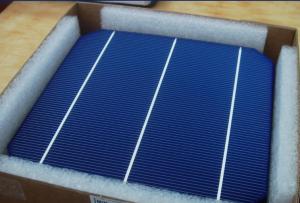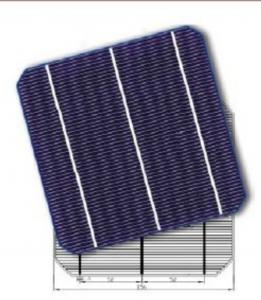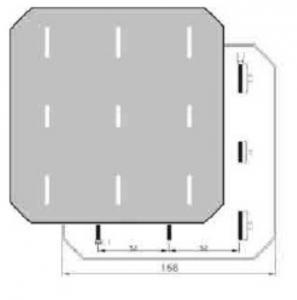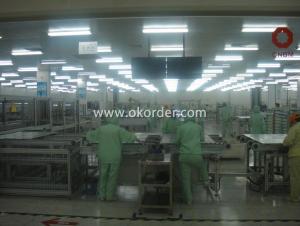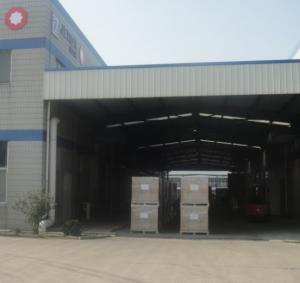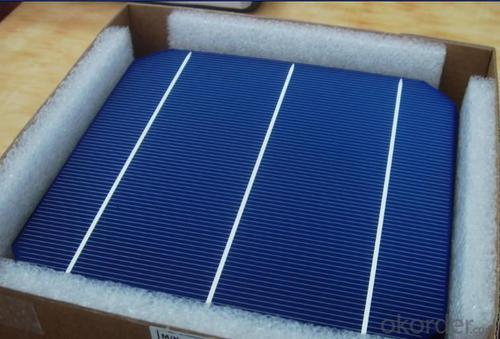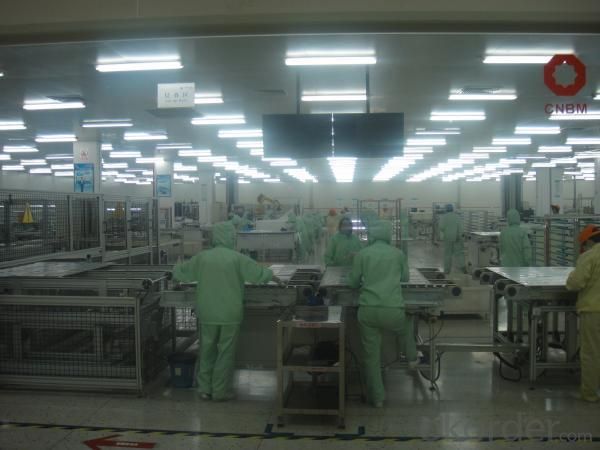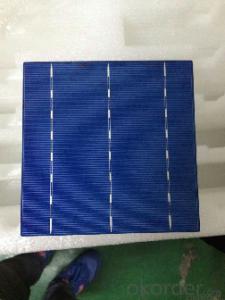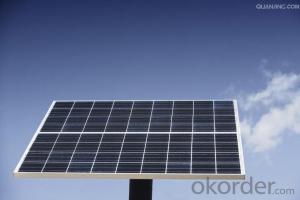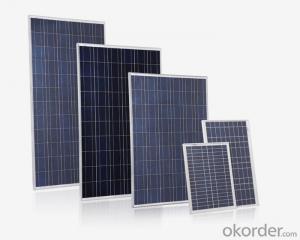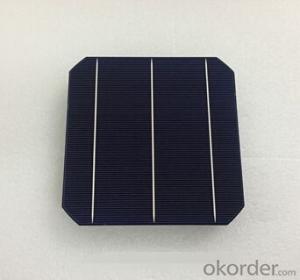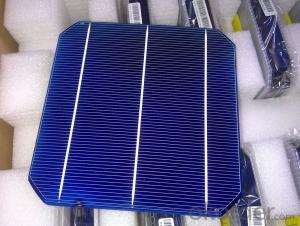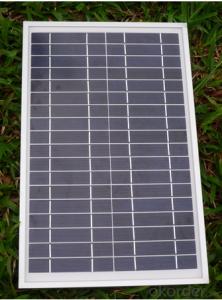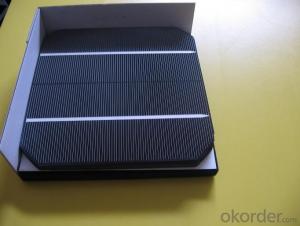Indium Phosphide Solar Cells - Level A High Quality Mono Solar Cell 156mm with TUV, CE Certification
- Loading Port:
- Tianjin
- Payment Terms:
- TT OR LC
- Min Order Qty:
- 4000 watt
- Supply Capability:
- 1000 watt/month
OKorder Service Pledge
OKorder Financial Service
You Might Also Like
Details Of Mono Solar Cell 156mm
Specifications Of Mono Solar Cell 156mm
1.Mechanical data and design
Format | 156 mm × 156 mm ± 0.5 mm |
Thickness | - 210 μm ± 40 μm |
Front(-) | 1.5 mm bus bars (silver),blue anti-reflection coating (silicon nitride) |
Back (+) | 2.5 mm wide soldering pads (silver) back surface field (aluminium) |
2.Temperature Coefficient of Cells
Voc. Temp . coef.%/K | -0.35%/K |
Isc . Temp . coef.%/K | +0.024%/K |
Pm. Temp. coef.%/K | -0.47%/K |
3.Electrical Characteristic
Efficiency (%) | Pmpp (W) | Umpp (V) | Impp (A) | Uoc (V) | Isc (A) | FF (%) |
18.35 | 4.384 | 0.526 | 8.333 | 0.63 | 8.877 | 78.3% |
18.20 | 4.349 | 0.526 | 8.263 | 0.63 | 8.789 | 78.54% |
18.05 | 4.313 | 0.525 | 8.216 | 0.63 | 8.741 | 78.32% |
17.90 | 4.277 | 0.524 | 8.161 | 0.629 | 8.713 | 78.04% |
17.75 | 4.241 | 0.523 | 8.116 | 0.629 | 8.678 | 77.70% |
17.60 | 4.206 | 0.521 | 8.073 | 0.628 | 8.657 | 77.36% |
17.45 | 4.170 | 0.519 | 8.039 | 0.628 | 8.633 | 76.92% |
17.30 | 4.134 | 0.517 | 8.004 | 0.626 | 8.622 | 76.59% |
17.15 | 4.098 | 0.516 | 7.938 | 0.625 | 8.537 | 76.80% |
17.00 | 4.062 | 0.512 | 7.933 | 0.625 | 8.531 | 76.18% |
16.75 | 4.002 | 0.511 | 7.828 | 0.625 | 8.499 | 75.34% |
16.50 | 3.943 | 0.510 | 7.828 | 0.625 | 8.484 | 74.36% |
4.Intensity Dependence
Intensity [W/m2] | Isc× [mA] | Voc× [mV] |
1000 | 1.00 | 1.000 |
900 | 0.90 | 0.989 |
500 | 0.50 | 0.963 |
300 | 0.30 | 0.939 |
200 | 0.20 | 0.920 |
Advantage Of Mono Solar Cell 156mm
1: high quality cell, Level A cell
2: Dimensione:125*125mm Diagonal:150mm / 165mm
Dimensione:156*156mm Diagonal:200mm
3: Qualified certification: TUV,CE certification.
4: Warranty: five years for whole unit
Usage/Application Of Mono Solar Cell 156mm
Monocrystalline solar cells are currently the fastest developing a solar cell, its structure and production process has been finalized, the products have been widely used for space and ground. Such solar cells with high purity silicon rods as raw materials. Silicon rods, material performance indicators in order to reduce production costs, and now solar terrestrial applications such as the use of solar grade somewhat relaxed. Some semiconductor devices can also be used for processing materials and discard the head and tail of silicon materials, solar cells after re-drawn into a dedicated silicon rods.
Packaging & Delivery Of Mono Solar Cell 156mm | |
Packaging Detai | Packaging Detail:Export Carton and Pallet or under customer request. |
Delivery Detail:10-20days | |
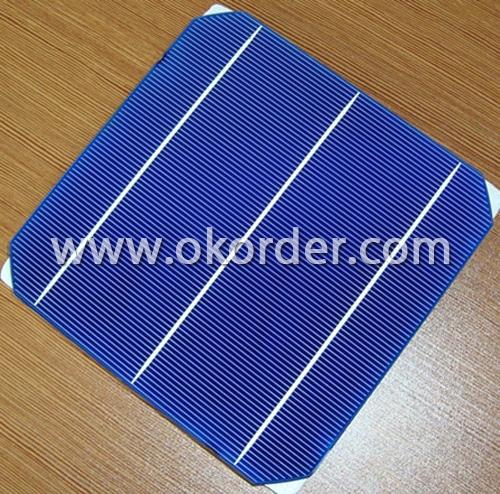
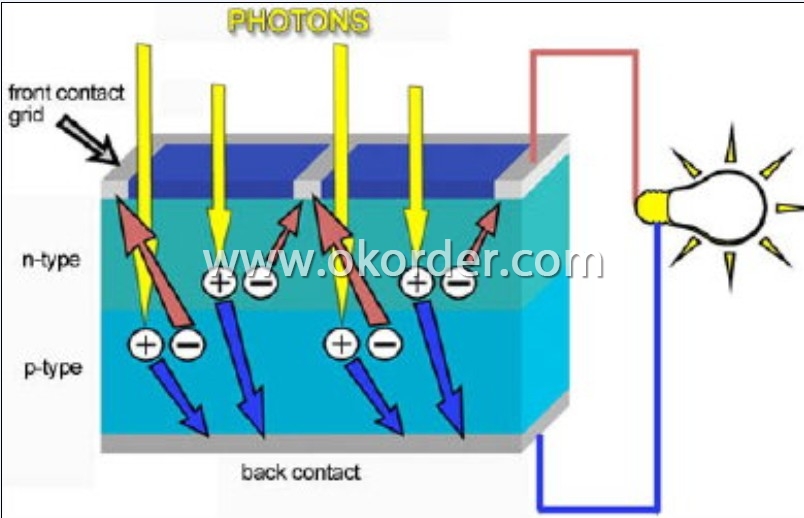
New Discovery of Solar Energy Material and Solar Cells
Nature prefers crystals. Salt, snowflakes, and quartz crystals are three typical examples, which is characterized by atoms and molecules are arranged in a unique lattice.
Industry also loves crystals. Electronic components is a crystal family, also known as semiconductors, the most famous is the silicon material.
In order to make semiconductor practical engineer must adjust its crystalline arrangement to control the start and stop the flow of electrons. Semiconducto r engineers need to know precisely the lattice energy of electrons required to move this energy value is called the energy gap. Similar to silicon, gallium arsenide and germanium and other semiconductor materials, they each have a unique energy gap of the crystal lattice. Through the determination of the energy gap, can determine what kind of material is suitable for electronic functions.
An interdisciplinary research team at Stanford University has successfully produced a semiconductor crystal with a variable energy gap. Such a semiconductor may be used as a solar cell, which is very sensitive to certain spectrum, from the sun to absorb more energy.
This raw material itself is not something new. Molybdenum disulfide (MoS2) is a crystalline rock, such as quartz, as a catalyst can be used to refine and lubricants.
Molybdenum disulfide is a single-layer structure: a triangular lattice of molybdenum atoms joins two sulfur. The nature of the rock is made up of many such single layer of material laminated together. Each has a single layer of molybdenum disulfide semiconductor potential applications.
Use of such a semiconductor material, we can get a great energy gap. This will have a beneficial aspect of the sensor, solar and other electronic applications.
Scientists have graphene endless praise. It found that graphene materials won the Nobel Prize, which is a single-layer structure consisting of a single layer of carbon atoms flat pendulum.
In 2012, the nuclear industry and MIT materials scientist devised a theory relates to semiconductor applications molybdenum disulfide monolayer. For any semiconductor, engineers must change its lattice arrangement so as to control the flow of electrons. For silicon, this adjustment comprises mixing a small amount of chemical substances in the crystal lattice.
Its scalability in the process is the most exciting thing. At the same time, from an industrial point of view, molybdenum disulfide very cheap.
- Q: What is the role of junction boxes in solar cell systems?
- Junction boxes in solar cell systems serve as important components that provide electrical connections and protect the solar panels. They house the electrical connections between multiple solar panels, ensuring a safe and efficient flow of electricity. Additionally, junction boxes act as a barrier, protecting the wiring and connections from environmental factors such as moisture and dust. Overall, junction boxes play a crucial role in the functionality and longevity of solar cell systems.
- Q: How do solar cells impact energy security?
- Solar cells have a positive impact on energy security as they provide a reliable and sustainable source of electricity. By harnessing the power of the sun, solar cells reduce dependence on finite fossil fuels, increasing energy independence and reducing the risks associated with fluctuating fuel prices and geopolitical conflicts. Additionally, solar energy can be generated locally, reducing the vulnerability of energy supply chains and enhancing resilience in the face of natural disasters or other disruptions. Overall, solar cells play a crucial role in diversifying the energy mix and enhancing energy security for individuals, communities, and nations.
- Q: Can the 156x156mm high efficiency single crystal cells assembly function better compared to the traditional one?
- I think so, because all the research and experiments already proved that.
- Q: Can solar cells be used in shopping centers?
- Yes, solar cells can be used in shopping centers. They can be installed on the rooftops or in parking lots to generate clean and renewable energy to power the shopping center's operations. Solar cells provide cost savings on electricity bills and reduce carbon emissions, making them an environmentally friendly choice for shopping centers.
- Q: Friends are fuel cells are chemical energy into electricity, solar cells are converted into electricity into electricity I would like to know in addition to the structure and the conversion of different ways there are no other differences hope that the specific power of everyone
- Fuel cell is very complex, involving chemical thermodynamics, electrochemistry, electrocatalysis, materials science, power systems and automatic control and other disciplines of the theory, with high power generation efficiency, less environmental pollution and so on.
- Q: Anybody ever heard of thin film solar cell? What it that?
- I did hear that term once, but can't remember what it is.
- Q: Can solar cells be used in water purification systems?
- Yes, solar cells can be used in water purification systems. Solar cells can generate electricity from sunlight, which can power various components of water purification systems such as pumps, filters, and disinfection processes. This enables the system to operate independently from the grid, making it suitable for remote or off-grid locations. Additionally, solar energy is a clean and sustainable power source, aligning with the environmentally-friendly nature of water purification processes.
- Q: Can solar cells be used for powering offshore oil rigs?
- Yes, solar cells can be used for powering offshore oil rigs. They can provide a renewable and clean energy source to supplement or replace traditional fossil fuel-based generators, reducing the environmental impact and operational costs of offshore oil operations.
- Q: Why and what is the low efficiency solar cell?
- Sometimes the solar cells made of bad quality silicon can cause the result that the solar cells you are using is lower efficient than when you started to use it. You might need to change some materials.
- Q: Can solar cells be used in drones?
- Yes, solar cells can be used in drones. In fact, many drones are equipped with solar panels to harness solar energy and power their operations. This helps to extend flight time, reduce reliance on traditional batteries, and make drones more sustainable and energy-efficient.
1. Manufacturer Overview
| Location | SanShui City, Guang Dong, China. |
| Year Established | 2009 |
| Annual Output Value | Above 10 billion RMB |
| Main Markets | Mid East;Western Europe;North America;Southeast Asia |
| Company Certifications | TUV ISO9001;SGS |
2. Manufacturer Certificates
| a) Certification Name | |
| Range | |
| Reference | |
| Validity Period |
3. Manufacturer Capability
| a) Trade Capacity | |
| Nearest Port | Zhuhai, Foshan |
| Export Percentage | 0.4 |
| No.of Employees in Trade Department | about 600 |
| Language Spoken: | English;Chinese; |
| b) Factory Information | |
| Factory Size: | 66666.7m2 |
| No. of Production Lines | 12 |
| Contract Manufacturing | OEM Service Offered;Design Service Offered |
| Product Price Range | USD 0.3-0.45/Wp |
Send your message to us
Indium Phosphide Solar Cells - Level A High Quality Mono Solar Cell 156mm with TUV, CE Certification
- Loading Port:
- Tianjin
- Payment Terms:
- TT OR LC
- Min Order Qty:
- 4000 watt
- Supply Capability:
- 1000 watt/month
OKorder Service Pledge
OKorder Financial Service
Similar products
Hot products
Hot Searches
Related keywords
